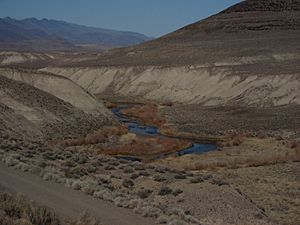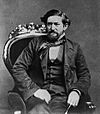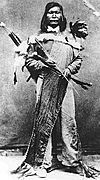Second Battle of Pyramid Lake facts for kids
Quick facts for kids Second Battle of Pyramid Lake |
|||||||
|---|---|---|---|---|---|---|---|
| Part of Pyramid Lake War | |||||||
 Truckee River Gorge, site of the battle |
|||||||
|
|||||||
| Belligerents | |||||||
| Paiute | |||||||
| Commanders and leaders | |||||||
| John C. Hays Joseph Stewart |
Numaga | ||||||
| Strength | |||||||
| 544 volunteers "Washoe Regiment" 207 Regulars 6th U.S. Infantry 3rd U.S. Artillery |
300 Paiute warriors | ||||||
| Casualties and losses | |||||||
| 3 killed 5 wounded |
25 killed about 20 wounded |
||||||
The Second Battle of Pyramid Lake was a major fight during the Paiute War in 1860. It's also known as the Battle of Truckee River. This battle happened after the United States forces lost the First Battle of Pyramid Lake. A strong group of soldiers and volunteers, led by the famous Texas Ranger Colonel John C. "Jack" Hays, fought against the Paiute warriors led by Chief Numaga. This was the last big battle of the Pyramid Lake War.
Contents
Why the Battle Happened
The Second Battle of Pyramid Lake was a direct response to an earlier defeat. On May 6, 1860, a group of Paiute people attacked a place called Williams Station. This station was along the Carson River in what is now Silver Springs, Nevada. Three white settlers were killed there.
After this attack, a group of local citizens, called vigilantes, decided to fight back. Major William Ormsby led them from Carson City and Virginia City. They went to fight the Paiutes near Pyramid Lake. However, Ormsby's group was badly defeated, and Major Ormsby himself was killed. This loss made the settlers ask for help from nearby California.
Getting Ready for Battle
Colonel John C. Hays answered the call for help. He traveled to Carson City to put together a group of 500 volunteers. He called this group the "Washoe Regiment." Another 165 volunteers joined from California towns like Placerville, Sacramento, and Nevada City. Colonel Hays then marched his regiment to Virginia City.
The U.S. Army also sent help. Captain Joseph Stewart left Fort Alcatraz with 144 regular soldiers. These soldiers were from the 3rd U.S. Artillery and 6th U.S. Infantry. Captain Stewart arrived in Carson City to wait for more orders. Meanwhile, Colonel Hays had already left Virginia City and marched to Williams Station. There, his group had a small fight with about 150 Paiute warriors. The warriors then went back to Pyramid Lake.
The Paiutes returned to their village near the mouth of the Truckee River. To keep them safe, they sent their women and children into the Black Rock Desert.
The Battle Begins
Colonel Hays followed the same path Major Ormsby had taken along the Truckee River. He set up camp near what is now Wadsworth. Captain Stewart and his regular soldiers joined the volunteers there. Colonel Hays was in charge of everyone.
On June 2, the battle started. Hays sent two companies (small groups of soldiers) ahead as an advance party. The main group moved more carefully, about eight miles downriver from their camp. This was much slower than Ormsby's earlier approach. The advance party found the bodies of Ormsby's soldiers from the previous battle, still unburied. The Paiutes then quickly moved toward the soldiers in a wedge shape. The advance party had to quickly pull back.
Colonel Hays chose a good spot to make a stand. It was a narrow canyon, about a mile wide. On the west side were steep mountains of the Virginia Range. To the east was the Truckee River. These natural features made it hard for the Paiutes to go around the soldiers. In the middle of the area was a rocky butte (a small, flat-topped hill). West of this butte, rain had created ditches in the sandy ground. These ditches were like natural walls, which either side could use for protection if they had to retreat.
The Paiute charge quickly took control of the butte. They spread their line from the river all the way into the mountains on the west. The Paiutes moved so fast that they took all the best spots for fighting. The soldiers had to set up their lines on flat ground to the south. Captain Stewart placed his regular soldiers in a line west of the butte, at the base of the mountains. The volunteers formed a line to the east, along the river.
Captain Edward Farris Storey and Captain J. B. Van Hagan led two groups of volunteers. One group was from Virginia City, and the other from California. They decided to charge the butte even before Hays had all his main forces in place. Storey and Van Hagan successfully captured the butte. For a short time, they were attacked from the sides as the Paiutes tried to surround them from the river bank and mountain slopes. This forward position was made safer when Hays moved the main army forward. Stewart pushed the warriors away from the mountain slopes. Hays and the volunteers moved steadily along the river. Soon, both sides had a continuous battle line, about a mile long, facing each other.
The battle continued for about three hours. Neither side seemed to be winning clearly. Finally, the Paiutes retreated up the canyon toward the lake.
On June 4, Captain Stewart chased after the Paiutes. He found their abandoned village at the mouth of the Truckee River. Colonel Hays followed Stewart north. On June 5, Hays sent a group of scouts through a canyon northeast of Pyramid Lake. These scouts were ambushed, and Private William Allen was killed. He was the last person to die in the war.
What Happened Next
Soon after Allen's death, Colonel Hays and the Washoe Regiment went back to Carson City. There, the regiment was officially ended. Major Ormsby's body was first buried near Pyramid Lake. Later, it was moved to a cemetery in Carson City. Captain Storey, who was badly hurt in the battle, died and was buried in Virginia City. Two counties in Nevada, Ormsby and Storey, were named after them.
Captain Stewart stayed in the Pyramid Lake area for a few more weeks. The Paiutes never returned to the area. His soldiers built several small forts made of earth around the lake. Stewart later decided to build a bigger fort along the Carson River instead. He started building it in 1861 and named it Fort Churchill.
The Battle Site Today
The place where the battle happened is now part of the Pyramid Lake Indian Reservation. Except for Nevada State Route 447 and an old railroad line, the land looks much the same as it did in 1860. There is a special sign, Nevada Historical Marker #148, near the intersection of S.R. 447 and Chicken Road. This spot would have been at the north end of the battlefield. The sign is called "The Two Battles of Pyramid Lake" and tells about both battles.




